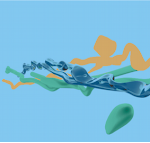 |
| Parasites, 2010, silk flowers, approx. 3 x 2 x 4 m |
Skulpturenpark Berlin Centrum is a part-time sculpture park in the very heart of Berlin, on the ancient border of the eastern and western parts of the city. The park consists of two separate lots, one big savannah-like wild park, while the other has piles of old bricks and sand among the grass and trees. Between art exhibitions, the sites wait for a new owner offering the locals a nice place to walk their dogs.
I was invited to participate in a group exhibition in Skulpturenpark Berlin Centrum in June 2010 by Katharina Hohmann, head of the Sculpture department at HEAD - Geneva University of Art and Design where I took part in an exchange program in fall 2009. In Berlin we worked together with a group of students from the Universität der Künste Berlin. The idea behind the exhibition was trying to find new points of view in the relationship between men and urban nature.
We Finns have this sacred relationship with nature. Although our lives no longer follow the rhythm of the day, nor very much even that of the seasons, it wasn't until about 60 years ago that we really abandoned the countryside and moved to the cities. And still, every summer, everyone who has the opportunity will head to the woods for a few months and live a quiet life in a modest house nearby a lake. I guess this is a way to remember the close relationship we used to have with nature.
So now that we spend most of our time in cities, parks are appreciated and we want them to be taken care of. Considering the longing we have for the countryside and forests, I don't see why urban nature could not have a bit more in common with the nature we so badly miss. Instead of wild flowers, we have planted bright arrangements of decorative flowerpots, often meant to guide pedestrians or to separate car lanes from each other. Trees stand in their small holes on the neatly cut grass. Everything is bright, colorful and extremely controlled.
According to me, time is the key element missing in urban nature. In a city, you can't really observe time passing by. Plants have limited areas to grow in, and they're kept neatly inside them. You will see no battle between the species. Nothing takes place unless the city's park department decides so, and nothing really changes gradually. In spring time, flowers appear from nowhere, and when they die, they're replaced. What would happen if we controlled the nature in our surroundings just a bit less ?
One funny story about our twisted relationship with nature is when I decided to help some neighbors to clean the inner yard of our building and prepare the garden for the summer. I asked about the fruits that one of our blooming trees would bear. "Decorative apples" the neighbor said. When I asked why they did not plant real apples, she said the organization had made this decision to prevent people from fighting over the apples. "Ok." This is when I figured something really weird happened to the way we understand nature and its resources.
It's fun to imagine, what a city would look like in, let's say, 10 years, if the nature that finds its way there was considered sacred and every seed that starts to grow would be left in peace. Alright, this might not be a perfect situation either, but I think the least we could do, is to declare all the unsold lots to be natural reserves. Then we, and generations to come, could observe how vegetation and animals would take over it. Sure, it would take time. But it would be a fun reminder of the real rhythm of nature, and the fact that it does not, in reality, care about our expectations, aestethical preferences or our desire for quick results. Possibly we would, in the process, come up with new ways of co-existing.
Links:
Maija Kovari
Skulpturenpark
Universität der Künste, Berlin
Haute Ecole d'Art et de Design, Genève
|||

 Suomeksi
Suomeksi








